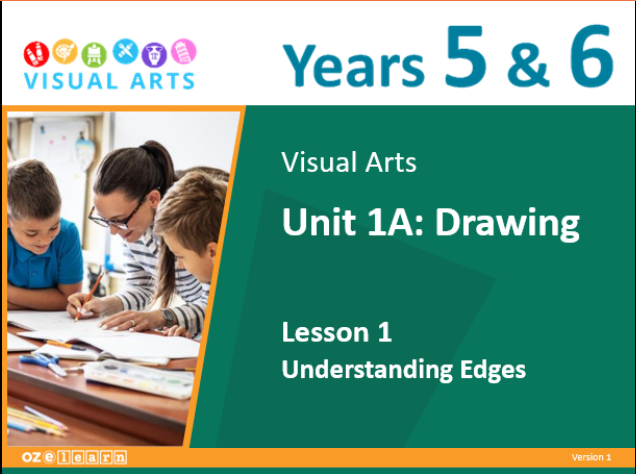Visual Arts
Starter Lessons
Unit Overviews
Teaching Resources
Overview
Unit 1A: Painting Years 5 and 6 is a Visual Arts unit for Years 5 and 6 students. It aligns with the Australian Curriculum content descriptions:
- Explore ideas and practices used by artists, including practices of Aboriginal and Torres Strait Islander artists, to represent different views, beliefs and opinions (ACAVAM114).
- Develop and apply techniques and processes when making their artworks (ACAVAM115).
- Plan the display of artworks to enhance their meaning for an audience (ACAVAM116).
- Explain how visual arts conventions communicate meaning by comparing artworks from different social, cultural and historical contexts, including Aboriginal and Torres Strait Islander artworks (ACAVAR117).
Learning Objectives
In Weeks 1–8, students learn:
- to identify and apply their understanding of contour lines and edges
- to identify and draw spaces and forms using both positive and negative space
- how artists communicate their ideas using specific practices in the development of their artworks
- how to compare and respond to different artworks from a range of cultural contexts, including Aboriginal and Torres Strait Islander Peoples
- to document and refine their creative process in their Process Journals.
Success Criteria
- Develop an understanding of colour theory and how to mix colour. of how edges and spaces make up a drawing (Week 1–).
- Apply drawing skills to produce a contour line drawing. (Weeks 9).
- Identify and compare the practices, ideas and meaning behind artworks from different cultural contexts (Weeks 1–8).
- Demonstrate an understanding of artworks studied in the creation of a response artwork (Weeks 1–8).
- Identify, evaluate, and compare the creative process and decision-making behind developing their artworks (Weeks 1–8).
Assessment
Continuous assessments
Continuous assessments are used to ascertain whether the knowledge recently taught has been understood by the student. These include oral tasks administered to individual students or written tasks administered to the whole class for an entire lesson. Written tasks are completed in the Student Workbook.
Final assessment
The final assessment occurs at the end of the unit in Week 10 and consists of a Final Self Portrait, a revised Process Journal with annotated drawing exercises and art analysis tasks, and a final reflection task and art display.
Unit 2A: Painting– Years 5 and 6
Teaching Resources
Overview
Unit 2A: Drawing Years 5 and 6 is a Visual Arts unit for Years 5 and 6 students. It aligns with the Australian Curriculum content descriptions:
- Explore ideas and practices used by artists, including practices of Aboriginal and Torres Strait Islander artists, to represent different views, beliefs and opinions (ACAVAM114).
- Develop and apply techniques and processes when making their artworks (ACAVAM115).
- Plan the display of artworks to enhance their meaning for an audience (ACAVAM116).
- Explain how visual arts conventions communicate meaning by comparing artworks from different social, cultural and historical contexts, including Aboriginal and Torres Strait Islander artworks (ACAVAR117)
Learning Objectives
In Weeks 1–8, students learn how to
- develop an understanding of colour theory and how to mix colour (Week 1)
- Practice using paint brushes with precision and control (Week 2)
- Identify ideas, practices, and meanings found in artwork (Week 3)
- Practice painting value scales (Week 4)
- learn how to visualise objects from different angles and sizes (Week 5)
- Identify the ideas, practices and meaning found in an artwork (Week 7)
- how artists communicate their ideas using specific practices in the development of their artworks
- how to compare and respond to different artworks from a range of cultural contexts, including Aboriginal and Torres Strait Islander Peoples
- to document and refine their creative process in their Process Journals.
Success Criteria
- Develop an understanding of colour theory and how to mix colour (Week 1)
- Practice using paint brushes with precision and control (Week 2)
- Identify ideas, practices, and meanings found in artwork (Week 3)
- Practice painting value scales (Week 4)
- learn how to visualise objects from different angles and sizes. (Week 5)
- Identify the ideas, practices and meaning found in an artwork. (Week 7)
Assessment
Continuous assessments
Continuous assessments are used to ascertain whether the knowledge recently taught has been understood by the student. These include oral tasks administered to individual students or written tasks administered to the whole class for an entire lesson. Written tasks are completed in the Student Workbook.
Final assessment
The final assessment occurs at the end of the unit in Week 10 and consists of a final summative painting, a revised Process Journal with annotated drawing exercises and art analysis tasks, and a final reflection task and art display.
Other Units
Coming Soon!


